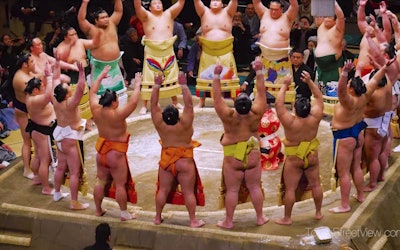Sumo Wrestling: A Martial Art and the Traditional National Sport of Japan Associated With Shinto. A Thrilling, World-Class Sport, Whose Spectacular Matches Fascinate Spectators!
Sports
A Look at Japan's Sumo Wrestling
"Sumo Match - Tokyo - 相撲" is a video produced by TokyoStreetView – Japan The Beautiful, featuring Japan’s national sport!
Sumo is a traditional martial art loved by the masses since old times in Japan.
As the matches are held internationally, the sport has many overseas fans and is capturing the world’s attention.
Matches between top wrestlers in the sumo rankings such as Yokozuna or Ozeki, are very spectacular and spectators can fully enjoy the thrilling matches.
The video features footage of a match between sekitori (a sumo ranking) during the New Year’s tournament held in January 2017.
Check out Japan’s spectacular sport - sumo wrestling!
About Sumo – Japan’s National Sport
Photo:Sumo Wrestling
The first written record of sumo in Japan is said to be found in a Shinto document called Kojiki.
Sumo matches used to be held as rituals and festivals dedicated to the deities and was mostly loved by nobles.
After gaining popularity among the masses during the Edo period (1603 – 1868 AD), sumo has been enjoyed as a form of entertainment and sport in Japan.
Today, matches are held both nationwide and internationally and many Japanese and foreigners enjoy it.
The manners and conventions rooted in the rituals are passed down and given special importance even in modern sumo wrestling.
The Excitement of Sumo
Source :YouTube screenshot
As the national sport of Japan, sumo wrestling starts from matches between low-ranking wrestlers, and matches between makuuchi (senior-grade wrestlers) are held in the evening.
Honbasho refers to the official tournaments that decide the rankings and rewards of the wrestlers and six tournaments are organized throughout the year: the first tournament in January (Tokyo), the spring tournament in March (Osaka), the summer tournament in May (Tokyo), the Nagoya tournament in July, the autumn tournament in September (Tokyo), and finally, the Kyushu tournament in November (Fukuoka).
Many Japanese people have probably watched the official tournaments aired on NHK (the national broadcaster in Japan).
Some may have a stiff image of the national sport, but that's not true at all.
Spectators can enter the venue at any time and watch the match in a relaxed manner while eating and drinking.
Matches between senior-grade wrestlers are a must-watch and you'll surely get excited watching the spectacular matches between well-built wrestlers.
Spectators get excited during matches, especially when a maegashira (the lowest grade of the highest ranking sumo class) wins against a yokozuna (the highest ranking sumo class) champion, as well as in deciding matches.
Tickets and information of those exciting sumo wrestling matches are available on the official website of Nihon Sumo Kyokai.
The Flow of a Sumo Match
Source :YouTube screenshot
As you can see at 0:22 in the video, wrestlers step into the ring with their colorful ornamental aprons before a match.
As businesses can offer rewards to support wrestlers, the “reward banners” with the names of those businesses go around the ring as you can see at 3:14 in the video.
With the company names printed on the program of the matches and publicly announced, those businesses play a similar role to sponsors in other sports.
Before a match, a ritual called "chirichouzu" is held.
You can see this at 3:08 and 7:52 in the video.
This is a declaration "to fight fair and square without any weapons."
Source :YouTube screenshot
Next, the wrestler creates distance from the opponent, bends forward, and places his hands on the ground.
This is called "shikiri" (仕切り).
Then, with the signal of the referee, the wrestlers push each other.
This is called "tachiai" (立合い).
This series of events can be seen in the video.
There are different means of attacking, such as thrusts, slapping, and body strikes.
Kimarite (決まり手, winning move) refers to the move that the opponent is defeated by.
Punching and grabbing the opponent's hair are prohibited moves in sumo.
Summary of Japan’s National Sport
Photo:Sumo
"Sumo Match - Tokyo - 相撲," produced by TokyoStreetView – Japan The Beautiful, features conventions before matches and match footage of Japan’s national sport.
From the cultural aspect of sumo that originates from Japanese Shinto to the spectacular matches, the video shows the sport at its best.
Sumo is a fascinating martial art that a wide range of people including those who are interested in Japanese culture and martial arts lovers can enjoy!
【Official Website】Nihon Sumo Kyokai Official Website
http://www.sumo.or.jp/En/
 Video article 11:32
Video article 11:32 Video article 10:54
Video article 10:54 Video article 39:12
Video article 39:12